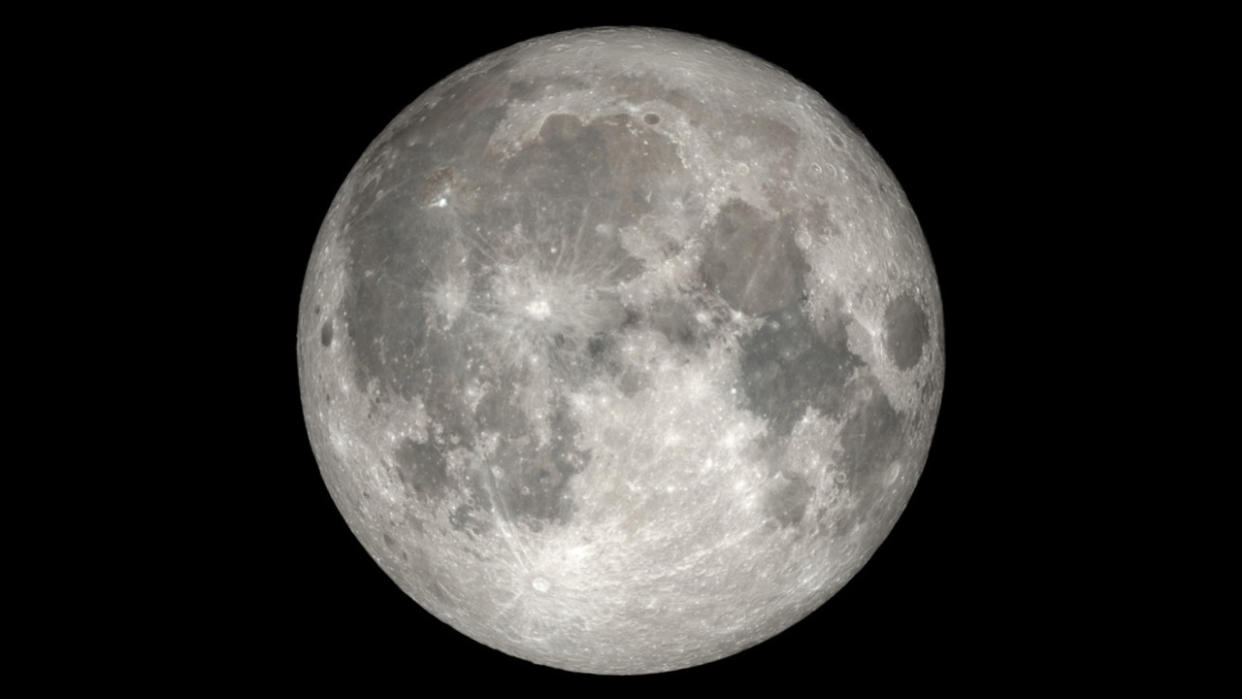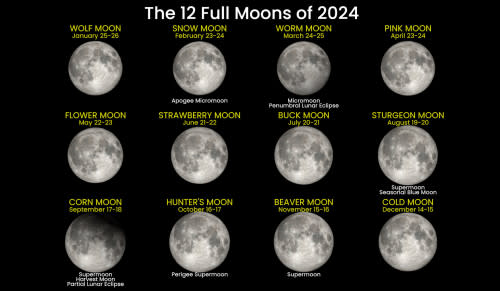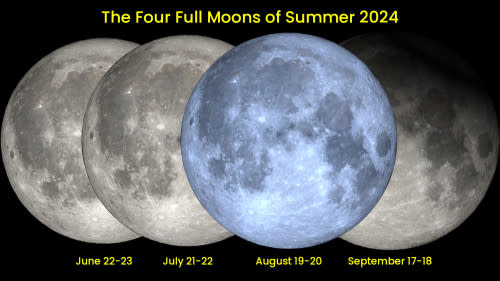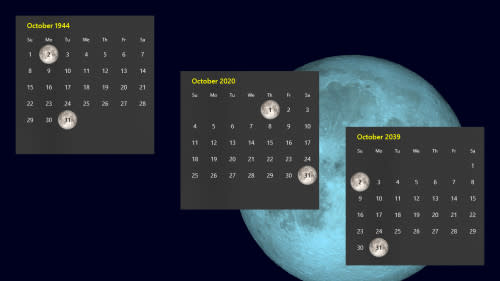Look up! The Full Buck Moon lights up the night sky this weekend

Eyes to the sky this weekend, to see July's Full Buck Moon shining throughout the nights.
At 6:17 a.m. EDT on Sunday, July 21, the Moon will reach 'syzygy' with the Earth and the Sun, as all three objects line up together in space. With the Moon on the opposite side of the Earth from the Sun, this will mark the July Full Moon.

The straight-line 'syzygy' of the Moon, Earth and Sun is shown in this simulated view from space, on the morning of July 21, 2024. The Sun may appear to be between the Earth and Moon in the centre view, however the inset view to the upper right shows the same arrangement from a different angle, revealing that it is a simple matter of perspective. The Moon is actually 'below' Earth's orbit at this time, near the lowest point in its tilted orbit around our planet, thus the 'centred' view places the Sun between Earth and the Moon. (Celestia/Scott Sutherland)
Although that exact moment in time is when the Moon reaches its 100 per cent Full phase, from our perspective here on Earth it will appear full from Friday night through Monday morning.
What is a 'Buck' Moon?
According to NASA, the July Full Moon goes by a variety of names from different cultures around the planet.
In western culture it is commonly called the Buck Moon. The Maine Farmer's Almanac picked this name nearly a century ago, which they borrowed from the Algonquin people of what is now the northeastern United States.
"Early summer is normally when the new antlers of buck deer push out of their foreheads in coatings of velvety fur," NASA wrote. "They also called this the Thunder Moon because of early Summer's frequent thunderstorms."
In parts of Europe, the July Full Moon is known as the Hay Moon, as this is traditionally the time of year for haymaking. It is also referred to as the Mead Moon.
Hindus, Buddhists, and Jains call it the Guru Full Moon (or Guru Purnima) — a time to honour spiritual or academic gurus.

This graphic collects all the relevant data about each of the 12 Full Moons of 2024, including their popular names, whether they are a 'super' or 'micro' Moon, a 'perigee' or 'apogee' Full Moon, and if they are remarkable in some other way (Harvest Moon, lunar eclipse, etc.). Credit: Scott Sutherland/NASA's Scientific Visualization Studio/Fred Espenak
It should be noted that the Moon names taken from First Nations people are not meant to only represent the Full Moons themselves.
More specifically, any particular moon refers to the Full Moon and the roughly 29-day period that follows it. Essentially, these are the names of the 'months' in the sophisticated lunar calendar invented by First Nations people to track the passage of time. The names they chose for those lunar months were inspired by nature, rather than the names of gods, men, and numbers used for the Gregorian calendar.
READ MORE: Blue Moon, lunar eclipse, fireballs: Your summer stargazing guide is here
Second Full Moon in a "Blue Moon" season
This Full Moon is the second of a total of four Full Moons for Summer 2024. While that isn't exceptional, in of itself, that does mean we're just about a month away from a Blue Moon.
With 12 Full Moons during a typical calendar year, we tend to see one each month and three every season. However, every two to three years, we get an 'extra' Full Moon.
If the first Full Moon of a season occurs within a day or two of the equinox or solstice that kicked that season off, we will then see four Full Moons before that season ends. This is simply due to the timing between Full Moons (roughly 29 days) being shorter than most of our Gregorian calendar months.
The first Full Moon of Summer 2024 fell on the night of June 21-22, just 28 hours after we observed the Summer Solstice. Following that, there are Full Moons on the nights of July 20-21, August 19-20, and then September 17-18. With the Fall Equinox occurring on the morning of September 22, that's four Full Moons this season rather than three.
In addition to its typical name, the third of those four Full Moons, on August 19-20, is also known as the Blue Moon.

The four Full Moons of Summer 2024. Although the August 20-21 Full Moon is shaded blue here, the Moon only turns the colour blue under very specific atmospheric conditions. The September 17-18 Full Moon has a shadow across it due to the Partial Lunar Eclipse that occurs on that night. (NASA GSFC/Scott Sutherland)
Having four Full Moons in an astronomical season isn't particularly remarkable for those of us using the Gregorian calendar. However, imagine an event occurring every three years or so that added an entire extra month to our year! Essentially, that is what's happening for anyone following a lunar calendar, as this lunar year has 13 lunar months instead of 12!
There is a different kind of Blue Moon, though, which is more exceptional for anyone using the Gregorian calendar.
A calendar Blue Moon is the second of two Full Moons that occur within the same calendar month.
This alternate version began as a misinterpretation of the original definition by astronomer James Pruett in the March 1946 issue of Sky & Telescope magazine. It may have ended there, as well, but Pruett's definition was then quoted by the American radio show Star Date in 1980, which led to it appearing in the children's book The Kids' World Almanac of Records and Facts in 1985, and the game Trivial Pursuit in 1986. In the years since, it has become part of the modern lexicon.

Three occurrences of 'Halloween Blue Moons', in 1944, then 2020, and again in 2039, demonstrate how we can have two Full Moons in the same calendar month. (NASA)
In a way, though, this version makes more sense as an 'exceptional' event these days. The Gregorian calendar tracks the same 12 months each year, with leap years being the only significant change. During each year, there are typically 12 Full Moons, with one observed each month. This even includes those years with a seasonal Blue Moon, like we have in 2024. Usually, the only thing that changes significantly from year to year is the exact night on which each month's Full Moon occurs.
Occasionally, though, we can see a total of 13 Full Moons during the course of a calendar year. That gives us an 'extra' one, and at some point during the year, we will have one Full Moon near the beginning of a calendar month, and then a second Full Moon at the end of that same calendar month. Since one lunation — the time between one Full Moon and the next — is just over 29 days, February is the only month of the year where this is impossible.
Since we only have 12 popular names for the Full Moons we observe throughout a year, that extra one would go nameless. Thus, during whichever month we see two Full Moons, the first of them receives the 'traditional' name, while the second is called a Blue Moon.
The last calendar Blue Moon occurred on August 31, 2023. In the years to come, we will see them again in 2026, 2028, 2031, and 2034. Then, in 2037, we will have two in the same year — one on January 31, and after the next Full Moon completely skips over the month of February, we will see another Blue Moon on March 31!
(Thumbnail image depicts the July 21 Full Moon, assembled from imagery captured by cameras on board the Lunar Reconnaissance Orbiter, courtesy NASA's Goddard Space Flight Center)

